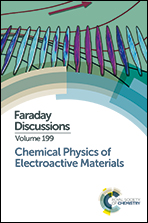Electrotunable lubricity with ionic liquids: the influence of nanoscale roughness
Abstract
The properties of ionic liquids can be modified by applying an external electrostatic potential, providing a route to control their performance in nanolubrication applications. Most computational studies to date have focused on the investigation of smooth surfaces. Real surfaces are generally inhomogeneous and feature roughness of different length scales. We report here a study of the possible effects that surface roughness may have on electrotunable lubricity with ionic liquids, performed here by means of non-equilibrium molecular dynamics simulations. In order to advance our understanding of the interplay of friction and substrate structure we investigate coarse grained models of ionic liquids confined in model surfaces with nanometer roughness. The friction is shown to depend on the roughness of the substrate and the direction of shear. For the investigated systems, the friction coefficient is found to increase with roughness. These results are in contrast with previous studies, where roughness induced reduction of friction was reported, and they highlight the strong sensitivity of the friction process to the structure of the surfaces. The friction force features a maximum at a specific surface charge density. This behaviour is reminiscent of the one reported in ionic liquids confined by flat surfaces, showing the generality of this physical effect in confined ionic liquids. We find that an increase of the substrate–liquid dispersion interactions shifts the maximum to lower surface charges. This effect opens a route to control electrotunable friction phenomena by tuning both the electrostatic potential and the composition of the confining surfaces.
- This article is part of the themed collection: Chemical Physics of Electroactive Materials


 Please wait while we load your content...
Please wait while we load your content...